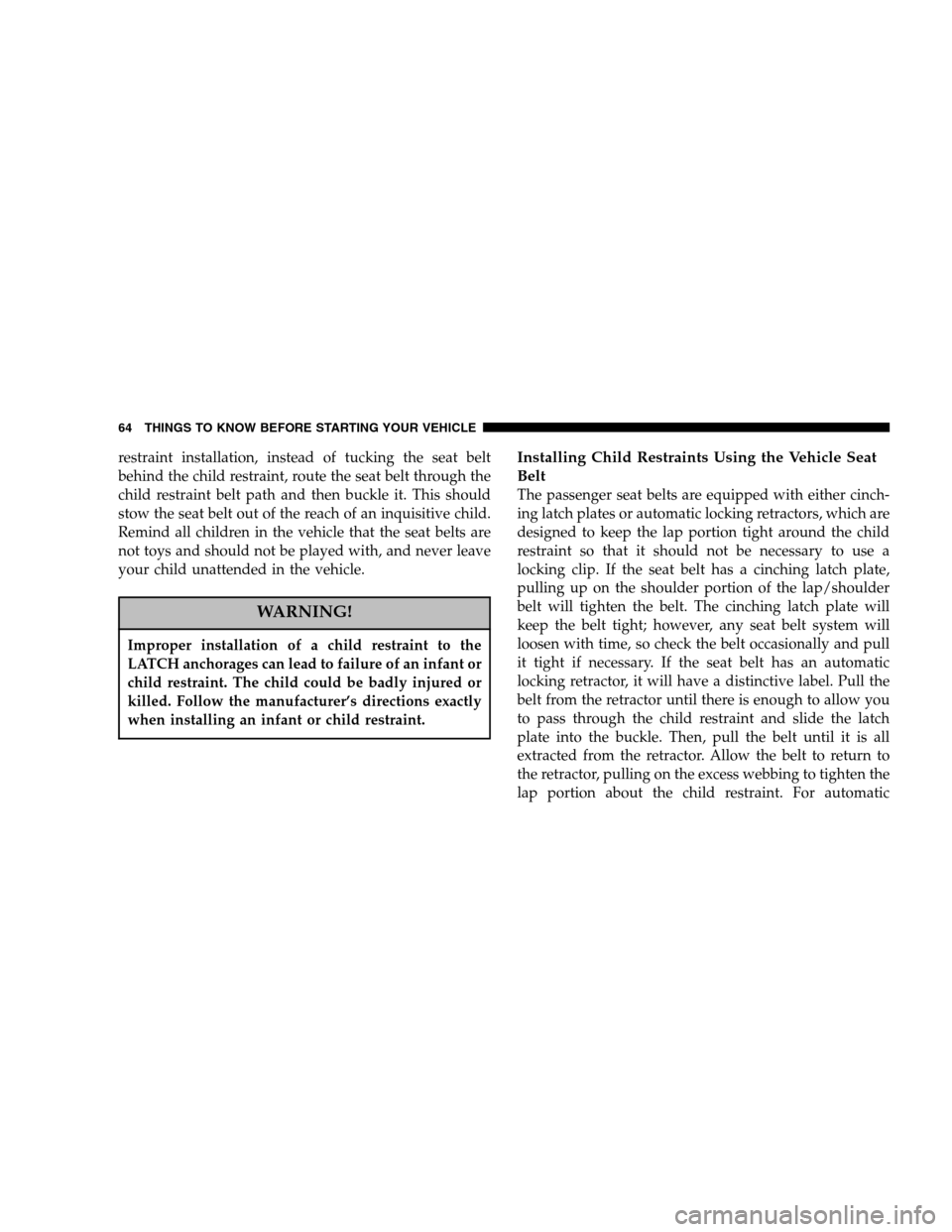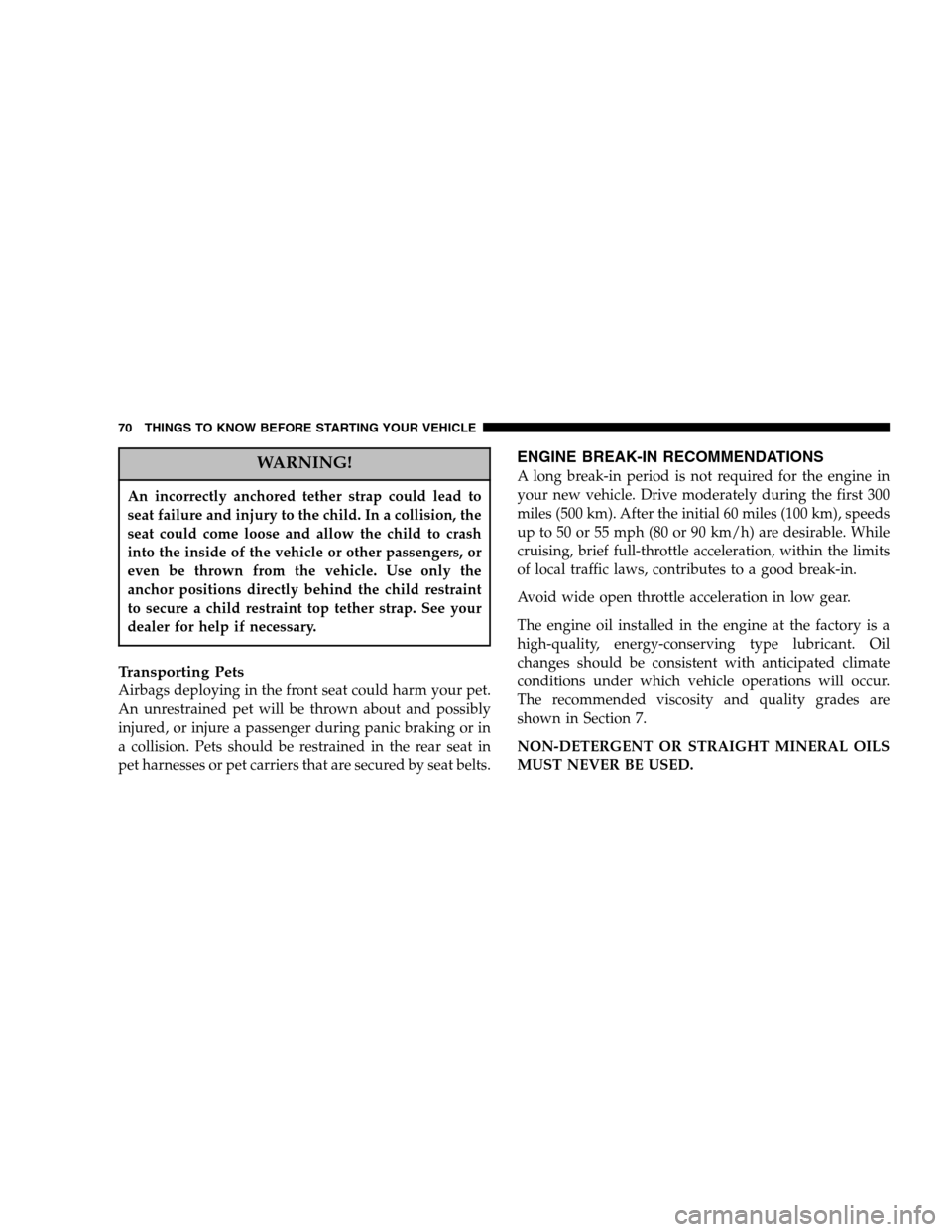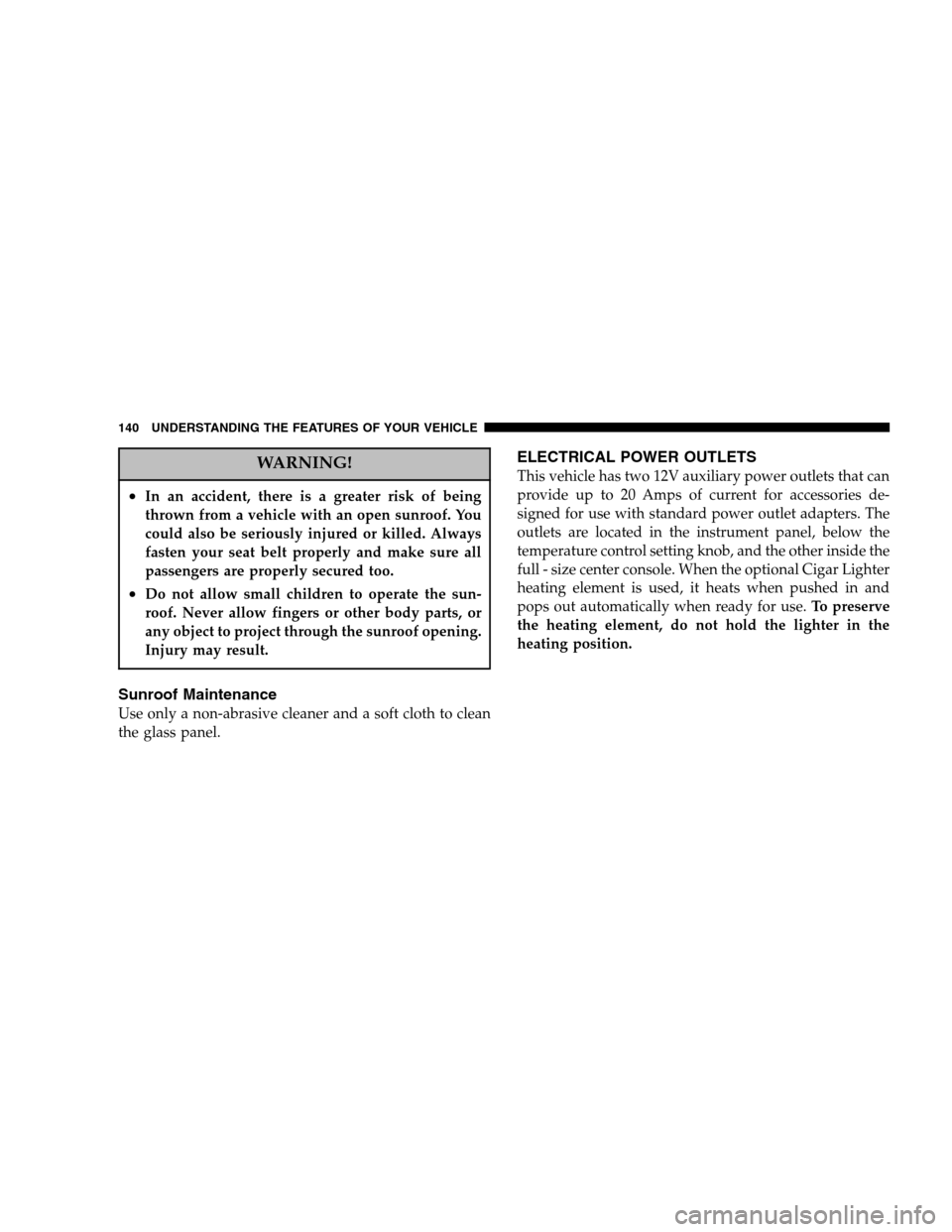Page 64 of 408

restraint installation, instead of tucking the seat belt
behind the child restraint, route the seat belt through the
child restraint belt path and then buckle it. This should
stow the seat belt out of the reach of an inquisitive child.
Remind all children in the vehicle that the seat belts are
not toys and should not be played with, and never leave
your child unattended in the vehicle.
WARNING!
Improper installation of a child restraint to the
LATCH anchorages can lead to failure of an infant or
child restraint. The child could be badly injured or
killed. Follow the manufacturer’s directions exactly
when installing an infant or child restraint.
Installing Child Restraints Using the Vehicle Seat
Belt
The passenger seat belts are equipped with either cinch-
ing latch plates or automatic locking retractors, which are
designed to keep the lap portion tight around the child
restraint so that it should not be necessary to use a
locking clip. If the seat belt has a cinching latch plate,
pulling up on the shoulder portion of the lap/shoulder
belt will tighten the belt. The cinching latch plate will
keep the belt tight; however, any seat belt system will
loosen with time, so check the belt occasionally and pull
it tight if necessary. If the seat belt has an automatic
locking retractor, it will have a distinctive label. Pull the
belt from the retractor until there is enough to allow you
to pass through the child restraint and slide the latch
plate into the buckle. Then, pull the belt until it is all
extracted from the retractor. Allow the belt to return to
the retractor, pulling on the excess webbing to tighten the
lap portion about the child restraint. For automatic
64 THINGS TO KNOW BEFORE STARTING YOUR VEHICLE
Page 65 of 408

locking retractor seat belts, refer to�Automatic Locking
Mode � earlier in this section. If you have trouble tighten-
ing the lap/shoulder belt on the child restraint because
the buckle or latch plate is too close to the belt path
opening on the restraint, follow these steps. If the buckle
is webbing mounted, disconnect the latch plate from the
buckle and twist the short buckle-end belt to shorten it.
Insert the latch plate into the buckle with the release
button facing out. If the belt still can’t be tightened, the
buckle is not webbing mounted, or if by pulling and
pushing on the restraint loosens the belt, you may need
to do something more. Disconnect the latch plate from
the buckle, turn the latch plate around, and insert the
latch plate into the buckle again. If you still can’t make
the child restraint secure, try a different seating position
or use the locking clip provided with your child restraint.
See the section �Child Restraint Tether Anchor �to com-
plete the child seat installation.Child Restraint Tether Anchor
The Club Cab model has two routing straps
located behind each of the rear outboard seat-
ing positions. The tether anchor itself is located
in the center of vehicle, in between the two
seating positions. The front outboard passenger seating
position is also equipped with a child tether anchorage,
located at the base of the front seat back. When there is a
rear seat delete option, the tether anchorage located on
the cab back panel is designed to be used for the front
seat center seating position. The Quad cab model has
three anchorages located behind each of the rear seating
positions (rear left, rear center, and rear right).
THINGS TO KNOW BEFORE STARTING YOUR VEHICLE 65
2
Page 66 of 408
WARNING!
With a child restraint installed in the rear driver or
passenger side locations, use care when adjusting
the front seat(s) rearward, to avoid the front seat
back coming in contact with the belted child directly
behind the seat. The child could be injured.
WARNING!
Improper installation can lead to failure of an infant
or child restraint. It could come loose in a collision.
The child could be seriously injured or killed. Make
sure the child restraint tether strap is always routed
through the proper anchor strap inner loop.
Tether Strap at the Front Passenger Seat (Club Cab)
1. Route the child restraint tether strap up and over the
front passenger seat back and under the head restraint.
2. Connect the tether strap to the lower anchor.
3. Remove the slack in the tether strap so that it is pulled
tight.
66 THINGS TO KNOW BEFORE STARTING YOUR VEHICLE
Page 67 of 408
Tether Straps at the Rear Passenger Seat (Club Cab)
1. Route the child restraint tether strap through the
routing loop, located directly behind the child restraint.
The routing loops are located behind the flip-down door
on the cab back panel (padded bolster). 2. Route the tether strap across to the center tether
anchorage. The center tether is located behind the slide
door in the center of the vehicle, between the two seating
positions.
3. Remove the slack in the tether strap so that the anchor
strap is pulled tight.
THINGS TO KNOW BEFORE STARTING YOUR VEHICLE 67
2
Page 68 of 408
Tether Straps at the Rear Passenger Seat (Quad Cab)
1. Route the child restraint tether strap under the head
restraint for the outboard seating positions, and then through the anchor strap outer loop (webbing material
loop), located directly behind the child restraint.
2. Route the tether strap across to the nearest installed
anchor strap, and attach the tether strap hook to the
anchor strap inner metal ring.
3. Remove the slack in the tether strap so that both
anchor straps are pulled tight.
NOTE:
Two Anchors must be used for any of the three
seating positions.
68 THINGS TO KNOW BEFORE STARTING YOUR VEHICLE
Page 70 of 408

WARNING!
An incorrectly anchored tether strap could lead to
seat failure and injury to the child. In a collision, the
seat could come loose and allow the child to crash
into the inside of the vehicle or other passengers, or
even be thrown from the vehicle. Use only the
anchor positions directly behind the child restraint
to secure a child restraint top tether strap. See your
dealer for help if necessary.
Transporting Pets
Airbags deploying in the front seat could harm your pet.
An unrestrained pet will be thrown about and possibly
injured, or injure a passenger during panic braking or in
a collision. Pets should be restrained in the rear seat in
pet harnesses or pet carriers that are secured by seat belts.
ENGINE BREAK-IN RECOMMENDATIONS
A long break-in period is not required for the engine in
your new vehicle. Drive moderately during the first 300
miles (500 km). After the initial 60 miles (100 km), speeds
up to 50 or 55 mph (80 or 90 km/h) are desirable. While
cruising, brief full-throttle acceleration, within the limits
of local traffic laws, contributes to a good break-in.
Avoid wide open throttle acceleration in low gear.
The engine oil installed in the engine at the factory is a
high-quality, energy-conserving type lubricant. Oil
changes should be consistent with anticipated climate
conditions under which vehicle operations will occur.
The recommended viscosity and quality grades are
shown in Section 7.
NON-DETERGENT OR STRAIGHT MINERAL OILS
MUST NEVER BE USED.
70 THINGS TO KNOW BEFORE STARTING YOUR VEHICLE
Page 140 of 408

WARNING!
•In an accident, there is a greater risk of being
thrown from a vehicle with an open sunroof. You
could also be seriously injured or killed. Always
fasten your seat belt properly and make sure all
passengers are properly secured too.
•Do not allow small children to operate the sun-
roof. Never allow fingers or other body parts, or
any object to project through the sunroof opening.
Injury may result.
Sunroof Maintenance
Use only a non-abrasive cleaner and a soft cloth to clean
the glass panel.
ELECTRICAL POWER OUTLETS
This vehicle has two 12V auxiliary power outlets that can
provide up to 20 Amps of current for accessories de-
signed for use with standard power outlet adapters. The
outlets are located in the instrument panel, below the
temperature control setting knob, and the other inside the
full - size center console. When the optional Cigar Lighter
heating element is used, it heats when pushed in and
pops out automatically when ready for use. To preserve
the heating element, do not hold the lighter in the
heating position.
140 UNDERSTANDING THE FEATURES OF YOUR VEHICLE
Page 392 of 408

Center High Mounted Stop Light............ 350
Center Seat Storage Compartment ............ 143
Certification Label ....................... 258
Changing A Flat Tire ..................... 284
Charging .............................. 293
Chart, Tire Sizing ........................ 231
Child Restraint ........................ 57,59
Child Restraint Tether Anchors .............60,65
Child Restraint with Automatic Belts ........... 37
Child Seat .............................. 62
Circuit Breakers ......................... 337
Climate Control ......................... 189
Clock ........................... 159,162,170
Compact Disc (CD) Maintenance ............. 188
Compact Spare Tire ...................... 242
Compass .............................. 129
Compass Calibration ..................... 129
Compass Variance ....................... 130
Computer, Trip/Travel .................... 126 Console, Floor
.......................... 142
Console, Overhead ....................... 125
Contract, Service ........................ 384
Converter, Catalytic ...................... 256
Coolant (Antifreeze) ...................... 324
Coolant Pressure Cap ..................... 323
Cooling System ......................... 320
Adding Coolant (Antifreeze) .............. 323
Coolant Capacity ...................... 355
Coolant Level ......................... 324
Disposal of Used Coolant ................ 321
Drain, Flush, and Refill .................. 321
Inspection ........................... 320
Points to Remember .................... 324
Radiator Cap ......................... 323
Selection of Coolant (Antifreeze) ......322,355,356
Temperature Gauge ..................... 152
Cruise Control (Speed Control) .............. 121
Cup Holder ............................ 144
392 INDEX